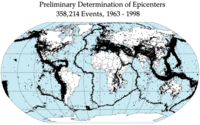
Photo from wikipedia
Abstract Permeability prediction is a key and difficult task in hydrocarbon reservoir characterization. Machine learning has long been studied for permeability prediction using porosity and wireline logs. However, machine learning,… Click to show full abstract
Abstract Permeability prediction is a key and difficult task in hydrocarbon reservoir characterization. Machine learning has long been studied for permeability prediction using porosity and wireline logs. However, machine learning, but has not been widely accepted and applied in reservoir characterization in real cases because it is always treated as a Black Box and hard to interpret. In this paper, we propose novel approaches called univariate predictive pattern (UPP) and bivariate predictive pattern (BPP) to visualize predictive patterns learned by machine learning models. Machine learning models for permeability prediction are built in advance, including support vector regression (SVR), random forest (RF), and deep residual neural network (ResNet). The visualized predictive patterns show that ResNet learns the best-fitted nonlinear porosity-permeability relationships from the training dataset, wa,bhich explains why ResNet achieves the best performance in permeability prediction in the scenario with porosity and wireline logs as input features. Wireline logs provide information about pore structure and contribute differently in machine learning models according to the visualized predictive patterns and quantitative sensitivity analysis. The proposed approach provides us a way to get a glimpse of the Black Box of machine learning models, and is also helpful in sensitivity analysis, feature selection, and model optimization for permeability prediction.
Journal Title: Journal of Petroleum Science and Engineering
Year Published: 2020
Link to full text (if available)
Share on Social Media: Sign Up to like & get
recommendations!